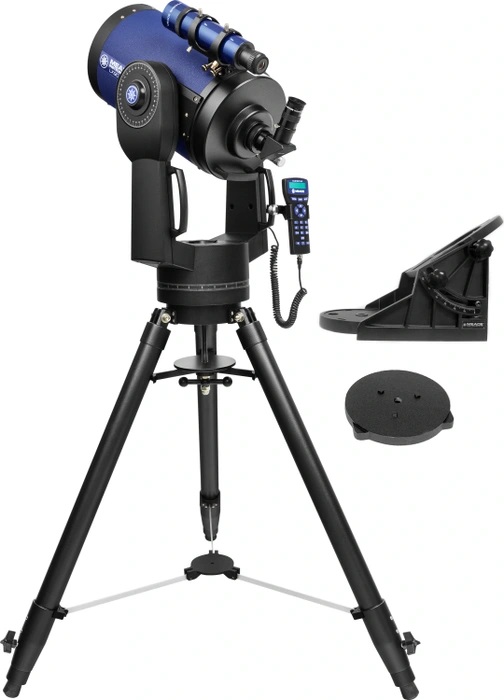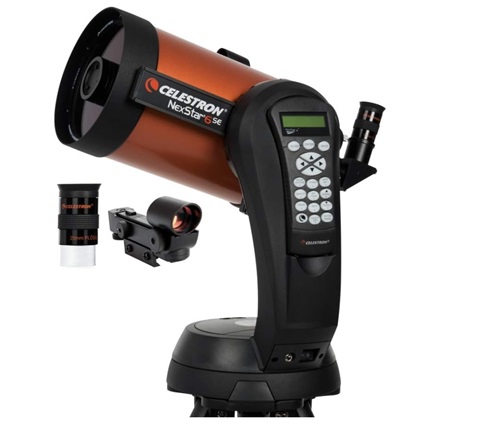Compound (Catadioptric) Telescopes: A Comprehensive Guide
Introduction
Compound telescopes, also known as catadioptric telescopes, combine the best features of refractor and reflector telescopes. These instruments utilize both lenses and mirrors to form images, providing high-quality views of celestial objects with less optical aberration. This article explores the workings, history, and types of compound telescopes, along with examples of consumer-available models.
How Compound Telescopes Work
Catadioptric telescopes use a combination of lenses and mirrors to correct optical aberrations such as chromatic and spherical aberrations. They consist of:
- Primary Mirror: A concave mirror that collects and focuses light.
- Corrector Lens: A lens that corrects spherical aberration introduced by the primary mirror.
- Secondary Mirror: A mirror that reflects the focused light back through a hole in the primary mirror or to the side for viewing.
The light path in a compound telescope typically follows this sequence:
- Light enters through the corrector lens.
- It reflects off the primary mirror towards the secondary mirror.
- The secondary mirror reflects the light back through the primary mirror's hole or to a side-mounted eyepiece.
This design allows for a compact telescope with a long focal length, ideal for both planetary and deep-sky observations.
History of Compound Telescopes
The development of catadioptric telescopes dates back to the early 20th century. Key milestones include:
- Schmidt Camera (1930): Invented by Bernhard Schmidt, this was the first successful catadioptric design, primarily used for wide-field astrophotography.
- Maksutov-Cassegrain (1941): Introduced by Dmitri Maksutov, this design improved upon the Schmidt camera by adding a meniscus corrector lens, resulting in better image quality and ease of use.

- Schmidt-Cassegrain Telescope (SCT) (1960s): Developed by Celestron, this design became popular among amateur astronomers for its versatility and portability. It uses a Schmidt corrector plate combined with a Cassegrain reflector system.

Examples of Catadioptric Telescopes
Schmidt-Cassegrain Telescopes (SCT)
- Celestron NexStar 8SE: This 8-inch SCT is renowned for its ease of use, computerized mount, and excellent optical performance. It's a popular choice for amateur astronomers.
- Meade LX200: Available in various apertures, the LX200 series offers advanced features like GPS, auto-align, and high-quality optics, making it suitable for serious enthusiasts.
Maksutov-Cassegrain Telescopes
- Sky-Watcher Skymax 127: Known for its sharp and contrasty views, this 5-inch Maksutov-Cassegrain is compact and portable, ideal for both beginners and experienced observers.
- Orion StarMax 90: This smaller, more affordable Maksutov-Cassegrain is perfect for those starting in astronomy, offering excellent planetary and lunar views.
Consumer-Available Refractor Telescopes
Though not compound telescopes, refractor telescopes are also popular among amateur astronomers. They use lenses to form images and are known for their sharp and high-contrast views. Examples include:
- Sky-Watcher Evostar 80ED: This 80mm apochromatic refractor offers excellent color correction and crisp images, making it a favorite for astrophotography and visual observation.
- Orion EON 115mm ED: A high-quality refractor with extra-low dispersion glass, providing clear and bright images with minimal chromatic aberration.
Top Compound Telescopes
Celestron - NexStar 6SE
- NEXSTAR 6SE COMPUTERIZED TELESCOPE: Celestron’s iconic orange tube telescope combines legendary 8" Schmidt-Cassegrian optics with updated technology and the latest features for an amazing stargazing experience for beginners and experienced observers..Resolution (Rayleigh) : 0.93 arc seconds. Resolution (Dawes) : 0.77 arc seconds.
- 6-INCH APERTURE SCHMIDT-CASSEGRAIN TELESCOPE: Large, 6-inch primary mirror packs enough light-gathering ability to deliver impressive views of the Moon and planets, along with deep-sky objects like the Orion Nebula, while retaining a compact form.
- FULLY-AUTOMATED GOTO MOUNT: With a database of 40,000+ celestial objects, NexStar SE's GoTo mount locates and tracks objects for you. It's the perfect telescope for astronomy beginners. NexStar SE is also compatible with StarSense and SkyPortal WiFi.
- EASY TO SET UP & USE: Assembling the telescope takes just a few minutes.Once you're set up, built-in SkyAlign technology helps you align the telescope fast. When you're done observing, the telescope breaks down into small components for easy storage.
- UNBEATABLE WARRANTY & SUPPORT: Buy with confidence from Celestron, a leading telescope brand in California since 1960. Your purchase includes a 2-Year US Warranty and unlimited support from our team of US-based experts.
- BONUS FREE STARRY NIGHT SOFTWARE: Your Celestron NexStar 6SE includes a free download of Starry Night Special Edition, one of the top-rated astronomy software programs. Simulate the night sky, learn about celestial objects, & plan observing session.
Meade 8" f/10 LX90 ACF

- 8" f/10 Advanced Coma Free Optics - 2032mm (f/10) focal length
- Ultra-High Transmission Coatings (UHTC)
- Features AudioStar: 30,000+ Object-Database and built-in GPS
- Internally powered via 8x C-cell batteries (not included) to operate the telescope up to 60 hours
- Special bundle includes 8" Equatorial Wedge (Meade #07002), Wedge Adapter Plate (Meade #07389), Series 4000 26mm Super Plössl, 8x50 finder, 1.25" diagonal, visual back and Standard Field Tripod
Celestron - NexStar 8SE Telescope

- Nexstar computerized telescope: The NexStar 8SE Computerized Telescope features Celestron’s iconic orange tube design with updated technology and the latest features for amazing stargazing for beginners and experienced observers.
- 8-Inch aperture: The 8-inch primary mirror in this Schmidt-Cassegrain telescope for adults and kids to be used together packs enough light-gathering ability to observe the best that our Solar System has to offer, while retaining a compact form factor. Compatible with starsense technology, Wifi
- Fully-automated go to mount: Featuring a database of more than 40,000 celestial objects, the go to mount built into our telescopes for astronomy beginners automatically locates and tracks objects for you.
- Easy to assemble and break down: The single fork arm design and sturdy steel tripod all assemble and break down from separate components for easy transportation. SkyAlign technology gets your telescope aligned and ready in minutes.
- Unbeatable warranty and customer support: Buy with confidence from the telescope brand, based in California since 1960. You’ll also receive a 2-year warranty and unlimited access to technical support from our team of US-based experts.
Conclusion
Compound (catadioptric) telescopes represent a significant advancement in astronomical optics, blending the best features of refractors and reflectors. Their compact design, versatile performance, and high-quality images make them a popular choice among amateur astronomers. From the Schmidt-Cassegrain to the Maksutov-Cassegrain, these telescopes continue to inspire and enable stargazers to explore the universe with clarity and precision. Whether you're a beginner or a seasoned astronomer, there's a catadioptric telescope out there to suit your needs and ignite your passion for the night sky.

